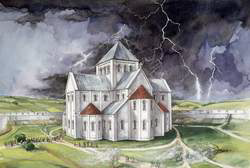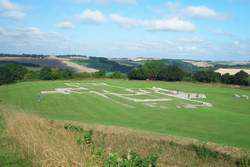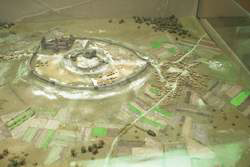Abandoned Communities ..... Old Sarum
Osmund's cathedral was consecrated in 1092. Just five days later, however, it was badly damaged in a storm. Osmund's successor as bishop, Roger, led the rebuilding and enlargement of the cathedral soon after 1100. Roger retained the original nave, but extended the eastern end and added larger transepts.
Over the centuries after the move to Salisbury the masonry from the cathedral was removed and re-used. In due course the site was covered by pasture, but in 1834 the plan of the cathedral was revealed in the grass during a period of exceptionally dry weather. Today it is clearly marked, in places by the base of the foundations, elsewhere by gravel of two colours that allow you to distinguish the first and the second buildings.
Apart from the castle, the royal palace, and the cathedral, there would have been a large civil settlement at Sarum. The Saxon borough of Serisberie was established there in the mid eleventh century. After the Norman occupation of Sarum many people would have been attracted to the town by the opportunities to provide a wide range of goods and services to the military and religious authorities. There would have been a market place, and probably several churches.
Remarkably little is known, however, about the civil settlement. There is uncertainty even about its main location. John Leland, sometimes described as the first English antiquary, recorded in 1540 that outside each of the east and west gates of Sarum there had been a fair suburb. He added that in the east suburb there had been houses inhabited in time of mind but at the time of writing there was not one house neither within Old Saresbyri or without inhabited. The interpretation of these comments does of course depend on the meaning attached by Leland to the word "suburb". He may have meant that the suburbs outside the two gates were subsidiary overspill areas, but it is at least as likely that he regarded the suburbs as the main regions of occupation.
At the Salisbury and South Wiltshire Museum, within the cathedral close at Salisbury, there is a splendid model of Old Sarum. When you build a model you are obliged to make definite decisions about the location of houses and other buildings. The view taken by the designer of the model was that there may have been some residential occupation inside the fortified area, but most of it lay outside the ramparts, in particular to the east and south of the east gate.
While this is now the prevailing view, some authors still prefer to place the main town within the defensive area. Daphne Stroud, for example, has used a variety of documentary evidence to support such a claim. The documents to which she refers are intriguing. They include the 1091 charter of Bishop Osmund, the papal enquiry of 1230 into the possible canonisation of Osmund, Bulls issued by Pope Honorius III in 1217 and 1218 in response to the request by the cathedral authorities to move to a new site, and a thirteenth century poem by Henry of Avranches. I have to say, however, that I am not convinced by the arguments put forward by Stroud. She places far too much weight, for example, on the fact that Henry of Avranches wrote "in castro stabat urbs castrum in urbe", "the city stood in the castle, the castle in the city". Taken literally this statement lacks logic, and surely it means no more than that the city and the castle were closely connected.
Daphne Stroud, The Site of the Borough of Old Sarum 1066-1226: An Examination of Some Documentary Evidence, Wiltshire Archaeological and Natural History Magazine, 1986, LXXX, 120-126.
Over the centuries after the move to Salisbury the masonry from the cathedral was removed and re-
Apart from the castle, the royal palace, and the cathedral, there would have been a large civil settlement at Sarum. The Saxon borough of Serisberie was established there in the mid eleventh century. After the Norman occupation of Sarum many people would have been attracted to the town by the opportunities to provide a wide range of goods and services to the military and religious authorities. There would have been a market place, and probably several churches.
Remarkably little is known, however, about the civil settlement. There is uncertainty even about its main location. John Leland, sometimes described as the first English antiquary, recorded in 1540 that outside each of the east and west gates of Sarum there had been a fair suburb. He added that in the east suburb there had been houses inhabited in time of mind but at the time of writing there was not one house neither within Old Saresbyri or without inhabited. The interpretation of these comments does of course depend on the meaning attached by Leland to the word "suburb". He may have meant that the suburbs outside the two gates were subsidiary overspill areas, but it is at least as likely that he regarded the suburbs as the main regions of occupation.
At the Salisbury and South Wiltshire Museum, within the cathedral close at Salisbury, there is a splendid model of Old Sarum. When you build a model you are obliged to make definite decisions about the location of houses and other buildings. The view taken by the designer of the model was that there may have been some residential occupation inside the fortified area, but most of it lay outside the ramparts, in particular to the east and south of the east gate.
While this is now the prevailing view, some authors still prefer to place the main town within the defensive area. Daphne Stroud, for example, has used a variety of documentary evidence to support such a claim. The documents to which she refers are intriguing. They include the 1091 charter of Bishop Osmund, the papal enquiry of 1230 into the possible canonisation of Osmund, Bulls issued by Pope Honorius III in 1217 and 1218 in response to the request by the cathedral authorities to move to a new site, and a thirteenth century poem by Henry of Avranches. I have to say, however, that I am not convinced by the arguments put forward by Stroud. She places far too much weight, for example, on the fact that Henry of Avranches wrote "in castro stabat urbs castrum in urbe", "the city stood in the castle, the castle in the city". Taken literally this statement lacks logic, and surely it means no more than that the city and the castle were closely connected.
Two
The first cathedral, struck by lightning
The outline of both cathedrals
Old Sarum may have looked like this


